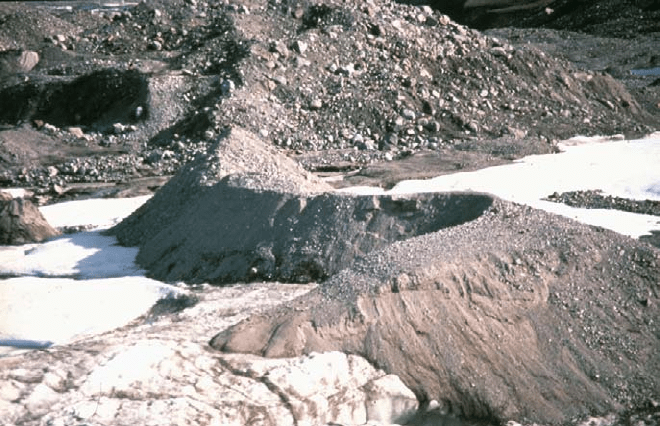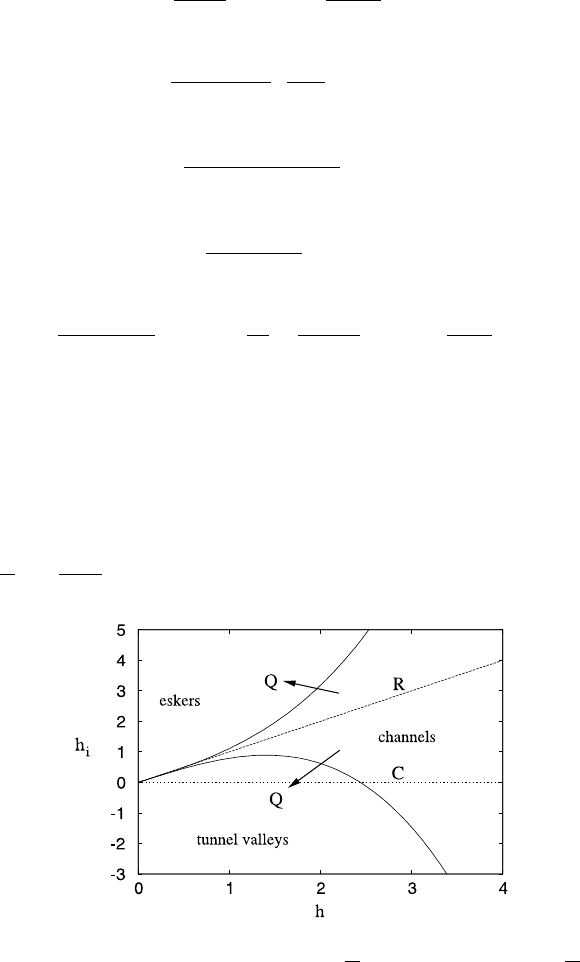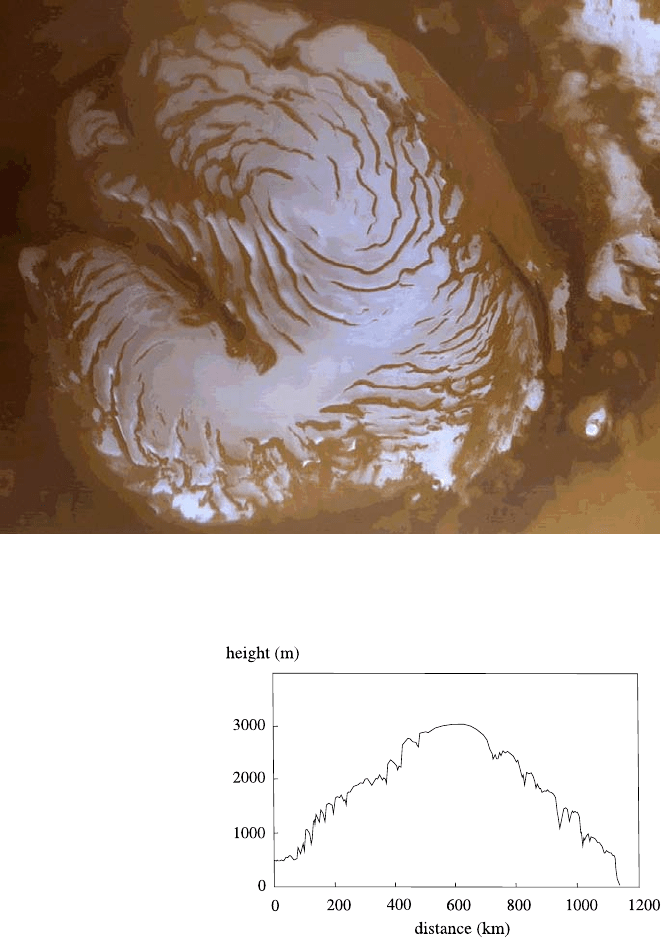Fowler A. Mathematical Geoscience
Подождите немного. Документ загружается.


700 10 Glaciers and Ice Sheets
Fig. 10.22 An esker which formed during retreat of the Stagnation Glacier, Bylot Island, Nunavut,
Canada, 72°57
41
N, 78°21
2
W, in 1992. The bouldery ridge in the background is the inner
face of the substantial lateral moraine surrounding the rapidly retreating glacier. The landform
is actually composed mostly of glacial ice preserved by the insulating cover of about a metre of
bouldery esker gravel. The height is estimated to be 8–10 m. Photograph by Christian Zdanowicz,
available at www.inrs.illinois.edu/shilts
the deposition of sediments in subglacial or ice-walled pro-glacial channels, and
form anastomosing patterns such as that in Fig. 10.18. On the ground, they look
asshowninFig.10.22, although eskers which form under ice sheets are generally
larger, having elevations in the range 10–50 m, and widths of 50–500 m. And they
are often shrouded in trees, and only properly visible from the air. In length, they can
sometimes be traced for hundreds of kilometres, although often they are segmented.
Indeed, eskers are often ‘beaded’, either consisting of independent beads, or having
oscillations in elevation along their length.
Because they consist of sorted sands and gravels, they are associated with chan-
nelised water flow, but the detailed way in which they form is not properly known.
Generally, they are associated with retreating ice, and are thought to form at the mar-
gin of the ice sheet. The sediment might be deposited within the subglacial channel.
Alternatively, deposits might occur pro-glacially in a stream walled by dead ice; or,
if the ice terminates in a pro-glacial lake, a sub-aqueous fan may occur. In all these
cases, one imagines the esker being built regressively as the ice retreats; however,
little is directly known of the process, and it is not inconceivable that eskers could
form wholly below the ice sheet.
Models for the construction of eskers do not yet exist, but a clue to their formula-
tion lies in our earlier discussion of different drainage theories. In our discussion of
canals (Sect. 10.3.3), we posited a drainage style in which a sediment-floored canal

10.5 Drumlins and Eskers 701
lay beneath an essentially flat roof. The astute reader will have been concerned as
to why the ice roof should be flat, as no grounds were given for this supposition.
Suppose the elevation of the ice roof above the local ice/till interface is h
i
, and the
depth of the stream base below it is h
s
. Then the Röthlisberger channel corresponds
to the assumption h
i
> 0, h
s
= 0, while the canal corresponds to the assumption
h
i
=0, h
s
> 0; an intermediate case has both being positive.
What is missing in our model is any reason for either assumption, but we can in
principle supply a reason by positing a model in which both h
i
and h
s
are variables.
We do this below, but now we can also realise that there is no reason why we cannot
also have the cases h
i
> 0, h
s
< 0 and h
i
< 0, h
s
> 0; in the former case, sediment
is deposited while the channel flow is maintained above it: this presumably corre-
sponds to esker formation. In the latter case, the ice squeezes down while the stream
evacuates the sediment; this corresponds to the formation of tunnel valleys.
27
Thus,
at least in principle, a single model could predict all these features.
To see the structure of such a model, we generalise the discussion in Sect. 10.3.3
to allow for separate ice roof elevation h
i
and sediment floor depth h
s
. In its simplest
form, the model is written
∂(wh
i
)
∂t
=
˙m
i
ρ
i
−
w
2
η
i
(N +ρ
wi
gh
i
),
∂(wh
s
)
∂t
=
˙m
s
ρ
s
−
w
2
η
s
(N +ρ
sw
gh
s
);
(10.395)
these represent the kinematic equations for the ice/water interface and the till/water
interface, respectively, and involve a melting rate ˙m
i
, erosion rate ˙m
s
, and ice and
till viscosities η
i
and η
s
.
28
The particular closure relations in (10.395) are those for a
wide channel, and for geometric simplicity we suppose the wetted perimeter l =2w,
where w is the channel width. From (10.238), (10.239), (10.240) and (10.242), we
have
˙m
i
=C
i
Q, (10.396)
where
C
i
=
ρ
i
gS
i
2L
. (10.397)
The erosion rate of a subglacial stream is a more complex matter. For a stream
with banks, we might suppose erosion of the sides by bank collapse is proportional
to the stream power. However, if the till squeezes up into the channel, there are no
‘banks’, and the erosion rate should presumably decrease to zero, unless we imagine
a stream of varying cross section, thus with erosion in the shallows, and the principal
27
Tunnel valleys are large (hundreds of metres deep, kilometres wide) braided systems of former
drainage channels (presumably), often infilled with sediment. They are found in Northern Germany
and Denmark, for example.
28
More exactly, they are parameters proportional to the viscosities with some suitable geometry-
dependent coefficients.

702 10 Glaciers and Ice Sheets
downstream sediment transport in the deeper flow. For such a case, it is plausible to
provide an analogous description for erosion rate,
˙m
s
=C
s
Q, (10.398)
where
C
s
=
ρ
i
gS
i
2L
E
, (10.399)
and L
E
is a term representing latent work of erosion. Finally, the extra gravitational
terms in the closure rates arise through the contribution of the respective bed eleva-
tions to the driving hydraulic closure stress.
If we take the Chézy friction law τ =fρ
w
u
2
, then u =
√
Ch, where
C =
ρ
i
gS
i
2fρ
w
, (10.400)
and the water flux is
Q =C
1/2
wh
3/2
, (10.401)
where h is the total depth,
h =h
i
+h
s
. (10.402)
If we suppose that sediment flux Q
s
is described by a Meyer-Peter and Müller
relation, then we have (cf. (6.14), or (5.5) and (5.6)),
Q
s
=K
w(h −h
c
)
3/2
, (10.403)
where
K
=
ρ
i
KS
i
ρ
sw
ρ
i
gS
i
8ρ
w
1/2
,h
c
=
2τ
∗
c
ρ
sw
D
s
ρ
i
S
i
, (10.404)
with τ
∗
c
≈0.05, K =8. The units of Q
s
are m
3
s
−1
.
In Röthlisberger channel theory, mass conservation of water determines the wa-
ter volume flux Q as a function of distance downstream, and we might suppose that
the equation of sediment conservation would likewise determine the sediment vol-
ume flux Q
s
, both of them being increasing functions of distance downstream. This
being so, the three equations in (10.395) and (10.402) serve to determine the three
quantities N, h
i
and h
s
, with the channel width w and depth h being determined by
(10.401) and (10.403). Unique values of h>h
c
and w exist provided
Q
s
Q
<
K
√
C
, (10.405)
and we suppose this to be true.
Steady solutions for h
i
and N are then
h
i
=
(A
i
−A
s
)h
3
ρ
si
Q
+
ρ
sw
ρ
si
h, (10.406)

10.5 Drumlins and Eskers 703
where
A
i
=
η
i
CC
i
ρ
i
g
,A
s
=
η
s
CC
s
ρ
s
g
, (10.407)
and
N =
gρ
wi
ρ
sw
ρ
si
h
2
β
2
Q
−1
h, (10.408)
where
β =
ρ
wi
ρ
sw
ρ
sw
A
i
+ρ
wi
A
s
1/2
. (10.409)
It is useful to write (10.406) in the form
h
i
=
B(1 −χ)h
3
Q
+rh, (10.410)
where
B =
ρ
i
gS
2
i
η
i
4fρ
w
ρ
si
L
,χ=
A
s
A
i
=
ρ
i
Lη
s
ρ
s
L
E
η
i
,r=
ρ
sw
ρ
si
. (10.411)
In Fig. 10.23 we plot representative graphs of h
i
versus h for values A
i
>A
s
(χ<1) and A
i
<A
s
(χ>1). The physically accessible space where h>0isdi-
vided into three regions. When 0 <h
i
<h, channels exist, with both the ice and
the sediment being excavated. There are two particular cases: h
i
= h corresponds
to a Röthlisberger channel, while h
i
= 0 corresponds to a canal. If h
i
>h, then
h
s
< 0: the sediment infiltrates the channel, causing an esker to form. If h
i
< 0, the
ice collapses, forming a tunnel valley.
As sediment flux and water discharge increase downstream, h (determined by
(1−
h
c
h
)
3
=
CQ
2
s
K
2
Q
2
) may increase or decrease; plausibly it remains constant (if Q
s
/Q
Fig. 10.23 Ice roof elevation in metres as a function of channel depth in metres, based on (10.411),
using values B =0.8ms
−1
, r =0.95, and values of χ =
A
s
A
i
=0.8(upper curve)andχ =
A
s
A
i
=1.2
(lower curve). Channels exist for small volume and sediment fluxes, but eskers or tunnel valleys
develop at larger fluxes, depending on the stiffness of the till. The lines h
i
= h (marked R) and
h
i
=0 (marked C) indicate Röthlisberger channels and canals, respectively

704 10 Glaciers and Ice Sheets
is constant). However, as Q increases, the upper and lower curves become steeper,
so that in this simple theory, eskers or tunnel valleys are promoted at larger water
fluxes, and which of them occurs depends sensitively on the stiffness of the till via
the definition of χ . Stiff till (high χ) promotes tunnel valley formation, while soft
till (high χ) promotes esker formation. Note that, from (10.408), N increases with
h, and is only positive for h>β
√
Q. We associate the lower limit with the onset of
channelised flow, supposing that for lower h, a distributed film flow exists, much as
discussed earlier.
The present discussion promotes a pedagogical point, which is that it may be
possible to provide an understanding of eskers and tunnel valleys, as well as Röthlis-
berger channels or canal, all on the basis of a self-consistent description of drainage
mechanics. However, our rudimentary discussion falls a fair way short of genuine
prediction. Most obviously, the ice viscosity depends on N, as does the till rheology
(strongly, if it is essentially plastic), and so the critical parameter χ will depend on
N and thus also h. In addition, variation with space and time is likely to be impor-
tant. Furthermore, it is not immediately obvious whether the drainage characteristics
of the different types of channel or canal are consistent with our earlier discussion
of them.
10.6 Glaciology on Mars
We are used to the existence of glaciers and ice sheets on Earth, but ice also exists
elsewhere in the solar system, and is the source of interesting and elusive phenom-
ena. As an example, we consider the polar ice caps of Mars. These apparently consist
largely of water ice, and that at the north pole is the larger, being comparable in size
to the Greenland ice sheet. Both ice caps are covered in their respective winters by
an annual layer of CO
2
frost, which sublimates in the summer, leaving the residual
ice caps.
We will focus our attention on the northern ice cap, shown in Fig. 10.24, which
is some 3 kilometres in depth, and 1000 km in horizontal extent. As can be seen in
the picture, this ice cap is quite unlike the large ice sheets on Earth. The surface is
irregular. In particular, there is a large canyon which looks as if it has been gouged
from the ice surface, towards the left of the picture. This is the Chasma Borealis.
The other pronounced feature of the ice cap consists of the stripes on the surface.
These stripes are arranged in a spiral, rotating anti-clockwise, and they consist of
concentrations of dust, associated with a series of troughs in the ice. Figure 10.25
shows the troughs, carved into a cross section of the ice cap.
The spiral waves suggest a formation mechanism similar to that of the Fitzhugh–
Nagumo equations, which form a reaction–diffusion system of activator-inhibitor
type. When the kinetics of the reaction terms are oscillatorily unstable, the addi-
tion of diffusion causes the oscillations to propagate as travelling waves. The pres-
ence of ‘impurities’ can cause these waves to propagate as spiral waves (cf. Ques-
tion 1.6).
We thus set out seeking a model whose time-dependent behaviour is oscillatory.
This can most easily be obtained by identifying a positive feedback in the system.

10.6 Glaciology on Mars 705
Fig. 10.24 Mars orbital camera (MOC) image of the North Polar Ice Cap of Mars. Image courtesy
NASA/JPL/Malin Space Science Systems
Fig. 10.25 A cross section of
the North Polar Ice Cap,
showing the scarps and
canyons. Redrawn from
Ivanov and Muhleman
(2000), reproduced with
permission of Academic
Press via Copyright
Clearance Center. The height
is relative to a plane 5 km
below the mean geoid. The
North Pole is near the summit
The mechanism we will use is that of dust-albedo feedback. Dust on the surface
causes a reduced albedo, and thus a greater absorption of solar radiation. In turn this
leads to greater sublimation of the ice, and thus increasing residual dust concentra-
tion.

706 10 Glaciers and Ice Sheets
Fundamental quantities in the model are thus the albedo a, the dust fraction of
ice at the surface, φ, and the mass rate of sublimation m
i
. The rate of sublimation
(or condensation) is given by
m
i
=K(p
s
−p), (10.412)
where the rate coefficient K depends on wind speed and temperature, p is atmo-
spheric water vapour pressure, and p
s
is the saturation vapour pressures, given in
terms of absolute temperature T by
p
s
=p
ref
s
exp
B
1 −
T
ref
T
, (10.413)
where p
s
=p
ref
s
at T = T
ref
; for water vapour, we may take T
ref
=273 K at p
ref
s
=
6 mbar (=600 Pa), the triple point, and the parameter B is given by
B =
M
w
L
RT
ref
, (10.414)
where M
w
is the molecular weight of water, and R is the gas constant.
Albedo and sublimation rate are related by the radiative energy balance law
I(1 −a) =
σT
4
Γ
+m
i
L, (10.415)
where I is received solar insolation, Γ is a greenhouse factor which may depend on
atmospheric dust and water vapour concentrations, and L is latent heat; the albedo
will depend on the amount of dust in the ice.
Let us denote the ice surface accumulation rate of dust as m
s
, with units of mass
per unit area per unit time. Then the rate of decrease of ice surface elevation due
both to sublimation/condensation and dust accrual is
s =
m
i
ρ
i
−
m
s
ρ
s
. (10.416)
The basic equation describing the ice cap elevation h is then the dimensional equiv-
alent of (10.45), which can be written in the form
∂h
∂t
=−s +
∂
∂x
D
i
∂h
∂x
, (10.417)
where the effective diffusion coefficient is given by
D
i
=
2A(ρg)
n
n +2
|h
x
|
n−1
h
n+2
, (10.418)
A being the Glen flow rate coefficient for ice, assumed constant. In our discussion
we will assume that D
i
is constant: a simple estimate of its appropriate size is D
i
∼
u
i
l
i
, where u
i
is a typical ice velocity, and l
i
is the ice cap radius.
29
29
A consequence of the assumption of constant D
i
will be that a finite gradient of h at the margin
will imply non-zero ice flux there. This is unrealistic, and in particular, the existence of a steady
state ice cap requires that the net balance be zero, i.e.,
l
i
0
sdx=0.

10.6 Glaciology on Mars 707
We introduce the atmospheric water vapour concentration ρ and the atmospheric
dust concentration c (both measured as mass per unit volume), noting that we may
expect the greenhouse factor Γ =Γ(ρ,c). The water vapour pressure is then given
by the perfect gas law
p =
ρRT
M
w
, (10.419)
where R is the gas constant and M
w
is the molecular weight of water. The subsidiary
variables m
i
, p
s
, T and p are defined by (10.412), (10.413), (10.415) and (10.419).
A further two relations are then necessary to determine ρ and c. These arise from
the concepts of sediment transport as expounded in Chap. 5.
First, we propose two equations which describe conservation of mass of dust and
water vapour in the near surface boundary layer. We will assume that a polar kata-
batic wind will flow downslope, transporting water vapour and dust in a thin near
surface current. This current will entrain dust and water vapour from the troposphere
above. If the current is of depth H , then suitable conservation laws for the vertically
averaged vapour and dust concentrations ρ and c in the katabatic layer are
∂(Hc)
∂t
+
∂(qc)
∂x
=E
c
+ρ
s
v
E
−v
s
c +
∂
∂x
D
c
H
∂c
∂x
,
∂(Hρ)
∂t
+
∂(qρ)
∂x
=E
ρ
+m
i
+
∂
∂x
D
ρ
H
∂ρ
∂x
,
(10.420)
where q is the katabatic wind flux, E
c
and E
ρ
are the entrainment rates of dust and
vapour from the overlying troposphere, and D
c
and D
ρ
are turbulent horizontal dif-
fusivities in the katabatic layer. Just as in Chap. 5,thetermρ
s
v
E
represents erosion
of dust from the surface, and the term v
s
c represents deposition of dust at the surface
via settling; v
s
is the settling velocity, and v
E
is an erosional velocity.
The velocities v
s
and v
E
need to be specified, as do the amounts of frozen and
unfrozen dust at the surface, and the ice dust accrual rate m
s
. A reasonably general
assumption about the surface is that there may be a thin surface layer of unfrozen
dust which mantles the ice. If the ‘depth’ of this layer is F ,
30
then conservation of
unfrozen dust takes the form
ρ
s
∂F
∂t
=−ρ
s
v
E
+v
s
c −m
s
. (10.421)
This layer is quite analogous to the bedload layer described in Sect. 6.4 (and F is
analogous to (1 −φ)a in (6.7)).
In addition, we suppose that the ice at the surface (below the unfrozen layer) con-
tains a volume fraction φ of dust. If F =0, we can expect in general that the albedo
is given by a =a(φ,F). It then remains to constitute φ and m
s
. Quite generally, we
find that for both sublimation and condensation
m
s
=−ρ
s
φs, (10.422)
30
More precisely, F is the volume of unfrozen dust per unit surface area.

708 10 Glaciers and Ice Sheets
and thus from (10.416)
m
i
=ρ
i
(1 −φ)s. (10.423)
If s>0,
φ =φ(x,τ),
t
τ
s(t
)dt
=0fors>0.
(10.424)
This simply states that if sublimation is occurring, the surface ice dust fraction is
equal to its value at the last time the surface was exposed. Actually, (10.424)isan
oversimplification, as it ignores the horizontal transport of the buried previous ice
surface by ice flow. If s<0, we suppose
φ =φ
s
,s<0, (10.425)
where φ
s
is the dust volume fraction of the unfrozen dust layer. This assumes that
F>0.
If F ≡ 0 over a time interval, then m
s
is still defined by (10.422), (10.421)is
irrelevant, and the ice surface dust fraction is determined by a balance between
volume of ice accretion and volume of dust deposited, thus
φ =
cv
s
−ρ
s
v
E
cv
s
−ρ
s
v
E
−r
si
m
i
,F≡0, (10.426)
so long as φ is positive, where
r
si
=
ρ
s
ρ
i
. (10.427)
The discussion above assumes implicitly that condensation of ice occurs directly
at the surface. A different possibility is that condensation occurs as snowfall. If the
snow crystals are pure, then there is no difference in the model. However, we might
also suppose that ice crystals nucleate on dust particles, so that dust accumulation
in the ice is partly due to this. If in fact there is no deposition of unfrozen dust (thus
F = 0), then when s<0 (it is snowing), the surface ice dust fraction will be that
of the snow particles. A simple partitioning by volume fraction of dust within snow
then suggests
φ =
c
c +r
si
ρ
,s<0 (snowfall). (10.428)
10.6.1 Non-dimensionalisation
We now proceed to make this model non-dimensional. We mostly denote appropri-
ate scales with a subscript zero, and in particular we scale the variables as
m ∼m
0
,p,p
s
∼p
0
,T∼T
0
,I∼I
0
,
s ∼s
0
,h∼h
0
,t∼t
0
,x∼l
i
,ρ∼ρ
0
,
c ∼c
0
,q∼q
0
,F∼F
0
,
(10.429)

10.6 Glaciology on Mars 709
and we write
1 −a
1 −a
0
=α, K =
K
κ
T
, (10.430)
and suppose K
is constant, such that κ = 1 when there is no surface dust layer,
F = 0: in general, we may expect κ to be a rapidly decreasing function of F ; a
0
is
the albedo of clean Martian ice. Balances of terms in the equations are effected by
writing
T
0
=
I
0
(1 −a
0
)
σ
1/4
,p
0
=p
ref
s
exp
B
1 −
T
ref
T
0
,
m
0
=
K
p
0
T
0
,s
0
=
m
0
ρ
i
,t
0
=
l
2
i
D
i
,
h
0
=s
0
t
0
,ρ
0
=
M
w
p
0
RT
0
;
(10.431)
in addition, the choice of q
0
is found from a prescription for the katabatic wind
(see below), while F
0
is the depth of an unfrozen dust layer over which κ decreases
significantly. Of the twelve scales in (10.429), (10.431) provides definition of seven;
in addition, q
0
and F
0
are determined as described above, while we suppose also that
I
0
is known from the received solar radiation. This leaves us two scales (l
i
and c
0
)
to be determined, and this will be done by prescription of two of the dimensionless
parameters which emerge in the model. We also write
v
E
=v
0
V
E
, (10.432)
and suppose v
0
is known.
The dimensionless version of the model can then be written in the form
h
t
=−s +h
xx
,
μc
t
+(qc)
x
=R
c
+ν(λV
E
−c) +Dc
xx
,
μρ
t
+(qρ)
x
=R
ρ
+γ(1 −φ)s +Dρ
xx
,
δF
t
=σ(c−λV
E
) +φs,
(10.433)
where
s =
κ
1 −φ
1
T
exp
β
1 −
1
T
−ρ
,
T =Γ
Iα−ε(1 −φ)s
,
(10.434)
and the parameters are defined by
μ =
Hl
i
q
0
t
0
,D=
D
c
H
q
0
l
i
=
D
ρ
H
q
0
l
i
,
δ =
F
0
h
0
,R
c
=
l
i
E
c
q
0
c
0
,R
ρ
=
l
i
E
ρ
q
0
ρ
0
,
β =
M
w
L
RT
0
,ε=
K
p
0
L
σT
5
0
,λ=
ρ
s
v
0
v
s
c
0
,
σ =
v
s
c
0
ρ
s
s
0
,ν=
v
s
l
i
q
0
,γ=
ρ
i
s
0
l
i
q
0
ρ
0
.
(10.435)
